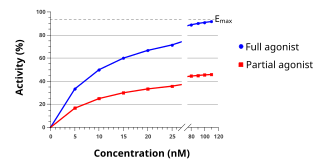
An agonist is a chemical that activates a receptor to produce a biological response. Receptors are cellular proteins whose activation causes the cell to modify what it is currently doing. In contrast, an antagonist blocks the action of the agonist, while an inverse agonist causes an action opposite to that of the agonist.
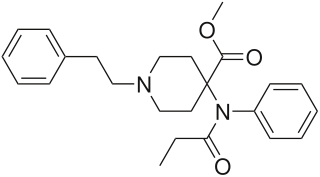
Carfentanil or carfentanyl, sold under the brand name Wildnil, is an extremely potent opioid analgesic used in veterinary medicine to anesthetize large animals such as elephants and rhinoceroses. It is typically administered in this context by tranquilizer dart. Carfentanil has also been used in humans to image opioid receptors. It has additionally been used as a recreational drug, typically by injection, insufflation, or inhalation. Deaths have been reported in association with carfentanil.

An opioid antagonist, or opioid receptor antagonist, is a receptor antagonist that acts on one or more of the opioid receptors.
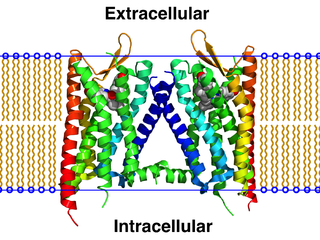
The κ-opioid receptor or kappa opioid receptor, abbreviated KOR or KOP for its ligand ketazocine, is a G protein-coupled receptor that in humans is encoded by the OPRK1 gene. The KOR is coupled to the G protein Gi/G0 and is one of four related receptors that bind opioid-like compounds in the brain and are responsible for mediating the effects of these compounds. These effects include altering nociception, consciousness, motor control, and mood. Dysregulation of this receptor system has been implicated in alcohol and drug addiction.

The μ-opioid receptors (MOR) are a class of opioid receptors with a high affinity for enkephalins and beta-endorphin, but a low affinity for dynorphins. They are also referred to as μ(mu)-opioid peptide (MOP) receptors. The prototypical μ-opioid receptor agonist is morphine, the primary psychoactive alkaloid in opium and for which the receptor was named, with mu being the first letter of Morpheus, the compound's namesake in the original Greek. It is an inhibitory G-protein coupled receptor that activates the Gi alpha subunit, inhibiting adenylate cyclase activity, lowering cAMP levels.

TRIMU-5 is a selective agonist of the μ2-opioid receptor and antagonist of the μ1-opioid receptor. It produces analgesia in animals that differs from that of conventional μ-opioid receptor agonists but that can still be blocked by μ-opioid receptor antagonists. TRIMU-5 can also block the analgesic effects of μ-opioid receptor agonists like morphine. In addition to analgesia, TRIMU-5 inhibits gastrointestinal transit, a known effect of μ2-opioid receptor activation.
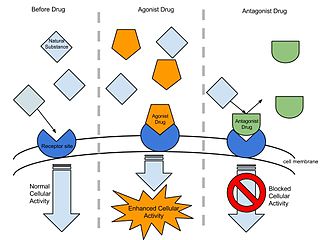
In pharmacology the term agonist-antagonist or mixed agonist/antagonist is used to refer to a drug which under some conditions behaves as an agonist while under other conditions, behaves as an antagonist.

U-50488 is a drug which acts as a highly selective κ-opioid agonist, but without any μ-opioid antagonist effects. It has analgesic, diuretic and antitussive effects, and reverses the memory impairment produced by anticholinergic drugs. U-50488 was one of the first selective kappa agonists invented and research on its derivatives has led to the development of a large family of related compounds. This compound has never received FDA approval and there are no reported human cases in the literature involving an U-50488 overdose.

Alazocine, also known more commonly as N-allylnormetazocine (NANM), is a synthetic opioid analgesic of the benzomorphan family related to metazocine, which was never marketed. In addition to its opioid activity, the drug is a sigma receptor agonist, and has been used widely in scientific research in studies of this receptor. Alazocine is described as a potent analgesic, psychotomimetic or hallucinogen, and opioid antagonist. Moreover, one of its enantiomers was the first compound that was found to selectively label the σ1 receptor, and led to the discovery and characterization of the receptor.
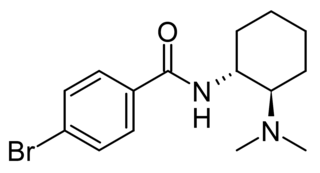
Bromadoline (U-47931E) is an opioid analgesic selective for the μ-opioid receptor developed by the Upjohn company in the 1970s. The drug has a potency lying between that of codeine and morphine, being slightly stronger than pentazocine. Bromadoline is related to AH-7921 and U-47700.

R-30490 is an opioid analgesic related to the highly potent animal tranquilizer carfentanil, and with only slightly lower potency. It was first synthesised by a team of chemists at Janssen Pharmaceutica led by Paul Janssen, who were investigating the structure-activity relationships of the fentanyl family of drugs. R-30490 was found to be the most selective agonist for the μ-opioid receptor out of all the fentanyl analogues tested, but it has never been introduced for medical use in humans, although the closely related drug sufentanil is widely used for analgesia and anesthesia during major surgery.

U-47700, also known as U4, pink heroin, pinky, and pink, is an opioid analgesic drug developed by a team at Upjohn in the 1970s which has around 7.5 times the potency of morphine in animal models.

Bucinnazine is an opioid analgesic drug that was widely used in China to treat pain in cancer patients as of 1986. It is one of the most potent compounds among a series of piperazine-amides first synthesized and reported in Japan in the 1970s. Bucinnazine has analgesic potency comparable to that of morphine but with a relatively higher therapeutic index.

4-Fluoroisobutyrylfentanyl (also known as 4-FIBF and p-FIBF) is an opioid analgesic that is an analog of butyrfentanyl and structural isomer of 4-Fluorobutyrfentanyl and has been sold online as a designer drug. It is closely related to 4-fluorofentanyl, which has an EC50 value of 4.2 nM for the human μ-opioid receptor. 4-fluoroisobutyrylfentanyl is a highly selective μ-opioid receptor agonist whose analgesic potency is almost ten times of that reported for morphine.

Metonitazene is an analgesic compound related to etonitazene, which was first reported in 1957, and has been shown to have approximately 1000 times the potency of morphine by central routes of administration, but if used orally it has been shown to have approximately 10 times the potency of morphine.

Metodesnitazene is a benzimidazole derivative with opioid effects, though unlike related compounds such as metonitazene and etodesnitazene which are many times more potent, metodesnitazene is only around the same potency as morphine in animal studies. It was proposed by the DEA to be placed under legal control in the US in December 2021.

N-Desethylisotonitazene (Norisotonitazene) is a benzimidazole derivative with potent opioid effects which has been sold as a designer drug. It was first identified as an active metabolite of the related compound isotonitazene, but was unexpectedly found to be similar potency compared to the parent compound, and is among the most potent opioid agonists in this family, around 20 times stronger than fentanyl. It has become an increasingly widespread drug of abuse in its own right, linked to numerous cases of drug overdose,and may be considered an analog of a schedule 1 drug in the US. On October 25 an intent to temporarily schedule Etonitazepipne and N-desethyl Isotonitazene was published.So on November 24 a month after publishing intent, it will most likely be placed in schedule 1.

3,4-MDO-U-47700 is an opioid analgesic which has been sold as a designer drug, first appearing in 2017 after U-47700 itself was banned in various jurisdictions. It is less potent than U-47700 but is still a full agonist at the μ-opioid receptor, with slightly higher potency than morphine. It is illegal in Virginia.

U-48800 is an opioid analgesic which has been sold as a designer drug. Unlike U-47700, it is primarily active as a kappa opioid receptor agonist with only moderate affinity at the mu opioid receptor. Nevertheless, it has still appeared on the recreational drug market, often as a component of combinations with other drugs, and has been linked to numerous drug overdose cases.














































